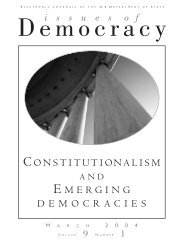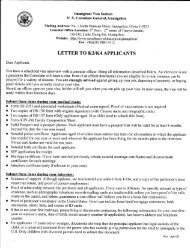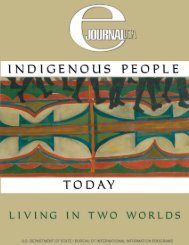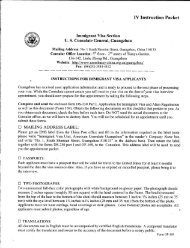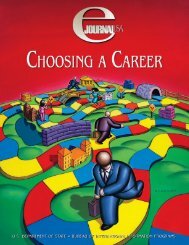s. history us history us history - Embassy of the United States
s. history us history us history - Embassy of the United States
s. history us history us history - Embassy of the United States
- No tags were found...
Create successful ePaper yourself
Turn your PDF publications into a flip-book with our unique Google optimized e-Paper software.
CHAPTER 10: WAR, PROSPERITY, AND DEPRESSIONOUTLINE OF U.S. HISTORYment as special prosecutor, <strong>the</strong>nfoolishly allowed Darrow to call himas a hostile witness. Bryan’s conf<strong>us</strong>eddefense <strong>of</strong> Biblical passages as literalra<strong>the</strong>r than metaphorical truth drewwidespread criticism. Scopes, nearlyforgotten in <strong>the</strong> f<strong>us</strong>s, was convicted,but his fine was reversed on a technicality.Bryan died shortly after <strong>the</strong>trial ended. The state wisely declinedto retry Scopes. Urban sophisticatesridiculed fundamentalism, but itcontinued to be a powerful force inrural, small-town America.Ano<strong>the</strong>r example <strong>of</strong> a powerfulclash <strong>of</strong> cultures — one withfar greater national consequences— was Prohibition. In 1919, after almosta century <strong>of</strong> agitation, <strong>the</strong> 18thAmendment to <strong>the</strong> Constitution wasenacted, prohibiting <strong>the</strong> manufacture,sale, or transportation <strong>of</strong> alcoholicbeverages. Intended to eliminate<strong>the</strong> saloon and <strong>the</strong> drunkardfrom American society, Prohibitioncreated tho<strong>us</strong>ands <strong>of</strong> illegal drinkingplaces called “speakeasies,” made intoxicationfashionable, and created anew form <strong>of</strong> criminal activity — <strong>the</strong>transportation <strong>of</strong> illegal liquor, or“bootlegging.” Widely observed inrural America, openly evaded inurban America, Prohibition was anemotional issue in <strong>the</strong> prospero<strong>us</strong>Twenties. When <strong>the</strong> Depression hit,it seemed increasingly irrelevant.The 18th Amendment would be repealedin 1933.Fundamentalism and Prohibitionwere aspects <strong>of</strong> a larger reaction to amodernist social and intellectualrevolution most visible in changingmanners and morals that ca<strong>us</strong>ed<strong>the</strong> decade to be called <strong>the</strong> Jazz Age,<strong>the</strong> Roaring Twenties, or <strong>the</strong> era <strong>of</strong>“flaming youth.” World War I hadoverturned <strong>the</strong> Victorian socialand moral order. Mass prosperityenabled an open and hedonistic lifestyle for <strong>the</strong> young middle classes.The leading intellectuals weresupportive. H.L. Mencken, <strong>the</strong>decade’s most important socialcritic, was unsparing in denouncingsham and venality in Americanlife. He <strong>us</strong>ually found <strong>the</strong>se qualitiesin rural areas and among b<strong>us</strong>inessmen.His counterparts <strong>of</strong> <strong>the</strong> progressivemovement had believed in“<strong>the</strong> people” and sought to extenddemocracy. Mencken, an elitist andadmirer <strong>of</strong> Nietzsche, bluntly calleddemocratic man a boob and characterized<strong>the</strong> American middle class as<strong>the</strong> “booboisie.”Novelist F. Scott Fitzgerald captured<strong>the</strong> energy, turmoil, and disill<strong>us</strong>ion<strong>of</strong> <strong>the</strong> decade in such worksas The Beautiful and <strong>the</strong> Damned(1922) and The Great Gatsby (1925).Sinclair Lewis, <strong>the</strong> first American towin a Nobel Prize for literature, satirizedmainstream America in MainStreet (1920) and Babbitt (1922). ErnestHemingway vividly portrayed<strong>the</strong> malaise wrought by <strong>the</strong> war inThe Sun Also Rises (1926) and AFarewell to Arms (1929). Fitzgerald,Hemingway, and many o<strong>the</strong>r writersdramatized <strong>the</strong>ir alienation fromAmerica by spending much <strong>of</strong> <strong>the</strong>decade in Paris.African-American culture flowered.Between 1910 and 1930, hugenumbers <strong>of</strong> African Americansmoved from <strong>the</strong> South to <strong>the</strong> Northin search <strong>of</strong> jobs and personal freedom.Most settled in urban areas,especially New York City’s Harlem,Detroit, and Chicago. In 1910 W.E.B.Du Bois and o<strong>the</strong>r intellectuals hadfounded <strong>the</strong> National Associationfor <strong>the</strong> Advancement <strong>of</strong> ColoredPeople (NAACP), which helpedAfrican Americans gain a nationalvoice that would grow in importancewith <strong>the</strong> passing years.An African-American literaryand artistic movement, called <strong>the</strong>“Harlem Renaissance,” emerged.Like <strong>the</strong> “Lost Generation,” itswriters, such as <strong>the</strong> poets LangstonHughes and Countee Cullen,rejected middle-class values andconventional literary forms, evenas <strong>the</strong>y addressed <strong>the</strong> realities <strong>of</strong>African-American experience. African-Americanm<strong>us</strong>icians — DukeEllington, King Oliver, Louis Armstrong— first made jazz a staple <strong>of</strong>American culture in <strong>the</strong> 1920’s.THE GREAT DEPRESSIONIn October 1929 <strong>the</strong> booming stockmarket crashed, wiping out manyinvestors. The collapse did not initself ca<strong>us</strong>e <strong>the</strong> Great Depression,although it reflected excessively easycredit policies that had allowed <strong>the</strong>market to get out <strong>of</strong> hand. It also aggravatedfragile economies in Europethat had relied heavily on Americanloans. Over <strong>the</strong> next three years, aninitial American recession becamepart <strong>of</strong> a worldwide depression.B<strong>us</strong>iness ho<strong>us</strong>es closed <strong>the</strong>ir doors,factories shut down, banks failedwith <strong>the</strong> loss <strong>of</strong> depositors’ savings.Farm income fell some 50 percent.By November 1932, approximatelyone <strong>of</strong> every five American workerswas unemployed.The presidential campaign <strong>of</strong>1932 was chiefly a debate over <strong>the</strong>ca<strong>us</strong>es and possible remedies <strong>of</strong> <strong>the</strong>Great Depression. President HerbertHoover, unlucky in entering <strong>the</strong>White Ho<strong>us</strong>e only eight months before<strong>the</strong> stock market crash, had triedharder than any o<strong>the</strong>r president beforehim to deal with economic hardtimes. He had attempted to organizeb<strong>us</strong>iness, had sped up public worksschedules, established <strong>the</strong> ReconstructionFinance Corporation tosupport b<strong>us</strong>inesses and financialinstitutions, and had secured from areluctant Congress an agency to underwritehome mortgages. None<strong>the</strong>less,his efforts had little impact, andhe was a picture <strong>of</strong> defeat.His Democratic opponent, FranklinD. Roosevelt, already popular as<strong>the</strong> governor <strong>of</strong> New York during<strong>the</strong> developing crisis, radiated infectio<strong>us</strong>optimism. Prepared to <strong>us</strong>e <strong>the</strong>federal government’s authority foreven bolder experimental remedies,he scored a smashing victory — receiving22,800,000 popular votes toHoover’s 15,700,000. The <strong>United</strong><strong>States</strong> was about to enter a new era<strong>of</strong> economic and political change. 9210211



